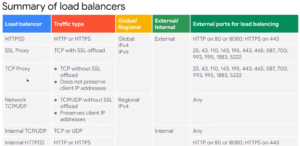Types of Load Balancers – GCP
Also read Unmanaged and Managed Instance Groups in GCP
GLOBAL Load Balancers
1. HTTPs load balancing Service in GCP
- AnyCast IP Address (Can be used anywhere),
- It is a proxy-based Layer 7 load balancer
- Port 80 , 443 and 8080 (Tomcat). 8080 was separate for Tomcat (based on a spec) because Apache web server could be running on the same server.
Backend Services for HTTPs load balancer
- An instance group with a balancing mode (CPU or RPS) and a capacity scaler (ceiling percentage)
Other Features
- Content based load balancing
- Health Check
- Session Affinity (Limits scaling, newer apps are stateless)
- Time out setting
2. SSL on HTTPs Load Balancer
- Up to 15 SSL Certificates (per target proxy)
3. SSL Proxy / TCP Proxy Load Balancer (Other than HTTP Protocols)
SSL Proxy Load Balancer
REGIONAL Load Balancers
1 Network TCP UPD Load Balancing - Regional, non proxied load balancer
- Managed Instance Groups and Auto Scaling
- Forwarding Rules (IP protocol data)
- Non Legacy health checks
- Connection Draining (when you remove a VM from an instance group)
- Configurable Failover Policy
2. Internal TCP UDP Load Balancer
3. Internal HTTPs Load Balancer (based on envoy open source, cloud native computing foundation)
The difference between 1 and 2 is that 1 preserves client IP Addresses.

Need an experienced Data Protection Expert? Anuj has successfully delivered over a dozen deployments on each of the public clouds (AWS/GCP/Azure) including several DevSecOps engagements. Set up a time with Anuj Varma.
Leave a Reply